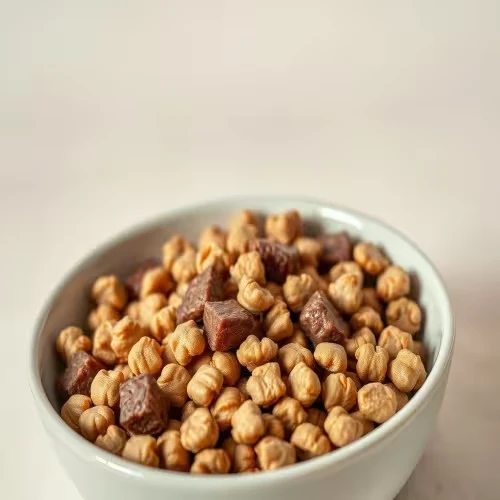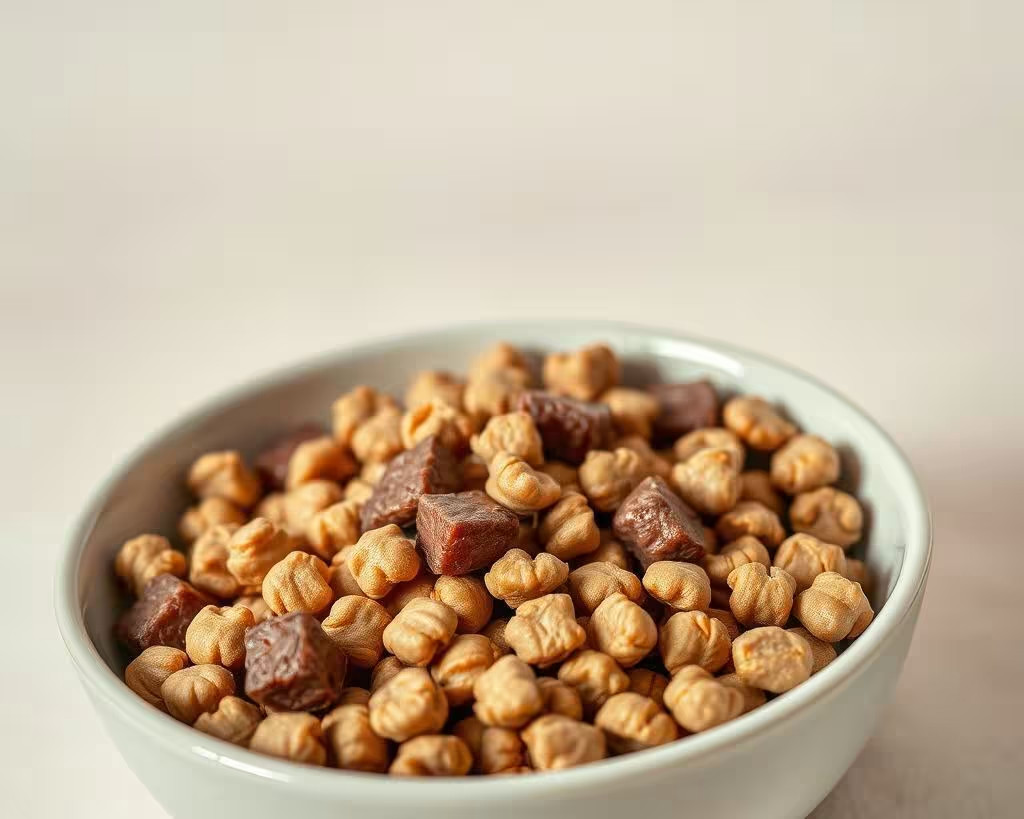Amazon Wag Dog Food Reviews: An Expert, Data-Driven Guide to Canine Nutrition

Choosing the right dog food can often feel like navigating a vast and confusing market. With countless brands, formulas, and marketing claims vying for your attention, it's easy for even the most dedicated pet owner to feel overwhelmed. Among the array of choices, Amazon's private label brand, Wag, has emerged as a popular and accessible option. But how does it truly stack up against established competitors, and is it the right choice for your beloved canine companion? This comprehensive, data-driven guide cuts through the noise, providing an in-depth analysis of Amazon Wag dog food, comparing it to leading brands, and equipping you with the knowledge to make informed nutritional decisions that support your dog's long-term health and happiness.
Understanding Your Canine's Core Nutritional Requirements
Before diving into specific brands or ingredients, it's paramount to grasp the fundamental nutritional needs of your dog. These requirements are dynamic, varying significantly based on several key factors:
Tailoring Diet to Breed, Age, and Activity Level
- Breed: Different breeds possess unique physiological traits. A giant breed like a Great Dane requires a diet formulated to support rapid growth without over-nutrition, potentially leading to orthopedic issues, unlike a toy breed such as a Chihuahua, which has a faster metabolism and different caloric needs.
- Age: Nutritional demands evolve across life stages. Puppies require higher calorie and specific nutrient profiles (like calcium and phosphorus in appropriate ratios) for healthy growth and development. Adult dogs need maintenance diets, while senior dogs often benefit from formulas with fewer calories, joint support, and easily digestible proteins to address age-related changes.
- Activity Level: A highly active working dog, an agility competitor, or a hunting dog expends significantly more energy than a sedentary companion dog. Their diets must reflect this, offering higher caloric density and sometimes increased protein and fat to fuel their performance and recovery.
Specialized Diets for Health Conditions and Life Stages
- Health Conditions: Dogs with specific health challenges, such as food allergies, sensitivities, diabetes, kidney disease, or cardiac issues, require specialized therapeutic diets. These formulations are typically developed by veterinary nutritionists and prescribed by veterinarians to manage symptoms and support overall health.
- Life Stage: Beyond general age categories, specific life stages like pregnancy or lactation demand heightened nutritional support. Pregnant or nursing mothers require increased caloric intake and specific vitamins and minerals to support their health and the development of their puppies.
Deciphering the Dog Food Label: What Every Owner Needs to Know
The information on a dog food label is far more than just marketing; it's a legal document governed by regulations designed to help consumers. Understanding its key components is essential for making an informed choice.
The Truth Behind Guaranteed Analysis and Ingredient Lists
- Guaranteed Analysis (GA): This section provides minimum percentages of crude protein, crude fat, and maximum percentages of crude fiber and moisture. While helpful for a baseline understanding, it doesn't indicate the *quality* or *digestibility* of these nutrients. For example, a food might have high crude protein, but if it comes from poorly digestible sources, much of it won't be utilized by your dog.
- Ingredient List: This is arguably the most crucial part of the label. Ingredients are listed in descending order by weight. Look for high-quality, recognizable protein sources (e.g., deboned chicken, salmon, lamb meal) as the first one or two ingredients. Be wary of ambiguous terms like "meat meal" without specifying the animal source. Whole grains (brown rice, barley) or specific vegetables (peas, sweet potatoes) are generally preferred over excessive fillers or by-products if not clearly defined.
AAFCO Statements and Their Importance
The Association of American Feed Control Officials (AAFCO) sets standards for pet food ingredient definitions and nutritional adequacy. A crucial statement to look for is one that confirms the food meets AAFCO nutritional requirements for a specific life stage (e.g., "complete and balanced for adult maintenance" or "for growth and reproduction"). This ensures the food contains all necessary nutrients in appropriate proportions for that particular life stage. Absence of an AAFCO statement is a red flag.
Navigating Additives and Preservatives
Many dog foods contain additives and preservatives to enhance flavor, color, or shelf life. While some, like tocopherols (Vitamin E) or rosemary extract, are natural and generally safe, many owners prefer to avoid artificial colors (e.g., Red 40, Blue 2), artificial flavors, and certain chemical preservatives (e.g., BHA, BHT, ethoxyquin), as their long-term effects are sometimes debated or associated with sensitivities in some animals.
A Closer Look at Dog Food Types and Their Benefits
The modern pet food market offers a diverse range of formats, each with its own set of advantages and considerations.
Dry Kibble: Convenience vs. Hydration
Dry kibble remains the most popular choice due to its cost-effectiveness, convenience, and long shelf life. It can also aid in dental hygiene by reducing plaque buildup, though not as effectively as brushing. However, it's low in moisture, which means dogs on an exclusively dry diet need consistent access to fresh water to ensure proper hydration.
Wet, Raw, Freeze-Dried, and Homemade Options
- Canned Wet Food: Higher in moisture content (typically 70-80%), which is beneficial for hydration, particularly for senior dogs or those with urinary tract issues. It's often highly palatable but generally more expensive and has a shorter shelf life once opened.
- Raw Food Diets (BARF - Biologically Appropriate Raw Food): Consisting of raw meat, bones, and organs, proponents believe it mimics a dog's ancestral diet. However, these diets require careful preparation to ensure complete and balanced nutrition and to mitigate risks of bacterial contamination (e.g., Salmonella) for both pets and humans. Consultation with a veterinary nutritionist is strongly recommended.
- Freeze-Dried Food: This option retains more nutrients than traditional kibble processing and often has superior palatability. It's lightweight, shelf-stable, and can be rehydrated or fed dry. It's typically more expensive than kibble.
- Homemade Diets: While offering complete control over ingredients, homemade diets are incredibly challenging to formulate to be nutritionally complete and balanced without expert guidance. Without precise formulation, they can lead to significant nutrient deficiencies or excesses. Consultation with a board-certified veterinary nutritionist is essential.

Deep Dive into Amazon Wag Dog Food Reviews: Unpacking the Brand
Amazon's venture into the pet food market with its Wag brand has garnered significant attention, primarily due to its accessible price point and the convenience of Amazon Prime delivery. But what exactly is Wag, and how does it perform under scrutiny?
Who Makes Wag? The Amazon Private Label Phenomenon
Amazon Wag is a private label brand, meaning it's owned and marketed by Amazon but manufactured by third parties. While Amazon oversees the branding and product specifications, the actual production is outsourced. This model allows Amazon to offer competitive pricing by streamlining supply chains and reducing marketing overhead compared to traditional pet food companies. While Amazon doesn't always disclose its manufacturing partners, they typically work with established co-packers in the pet food industry.
Key Ingredients and Nutritional Profile of Wag Formulas
Wag offers a range of dry dog food formulas, often emphasizing real meat as the first ingredient and including various grain-free options. For instance, a common Wag formula like the Wag Dry Dog Food, Salmon & Lentil Recipe, typically features:
- Protein: ~25-30%
- Fat: ~15-18%
- Fiber: ~4-6%
- Key Ingredients: Deboned salmon, lentils, pea protein, peas, salmon meal, chickpeas. Many formulas are grain-free, using legumes and potatoes as carbohydrate sources.
These nutritional percentages are generally in line with adult maintenance formulas. Wag prides itself on avoiding corn, wheat, soy, artificial colors, and artificial flavors in many of its recipes. However, the reliance on legumes in some grain-free formulas has been a point of discussion in the broader veterinary community regarding potential links to dilated cardiomyopathy (DCM) in some dogs, though research is ongoing and complex.
Price Point and Accessibility
One of Wag's most significant selling points is its affordability. With an estimated price point of around $1.50 - $2.00 per pound (depending on bag size and specific formula), it positions itself as a budget-friendly option compared to many premium brands, while still claiming quality ingredients. Its availability through Amazon, with rapid delivery, makes it highly convenient for many consumers.
Common User Experiences and Feedback
Feedback on Amazon Wag is mixed, as is common with most dog foods:
- Pros often cited by users: Affordability, convenience of delivery, good ingredient list for the price (e.g., real meat first ingredient, grain-free options), good palatability for many dogs.
- Cons often cited by users: Some owners report digestive upset (gas, loose stools) when switching, which can be true of any new food. A limited number of reports mention skin issues or lack of excitement in picky eaters. Transparency regarding ingredient sourcing and specific manufacturing facilities is not as robust as some heritage brands, which can be a concern for some owners.
- Recall History: It's important to note that Wag had a limited recall in 2018 for elevated Vitamin D levels in a specific formula (Wag Beef Dry Dog Food). While recalls can happen to any brand, transparency and how a company handles them are critical.

Data-Driven Comparison: Wag vs. Leading Dog Food Brands
To provide context for Amazon Wag, let's compare its typical profile to three other popular and reputable dog food brands. Please note that nutritional values and prices are representative averages and can vary significantly by specific formula, bag size, and retailer. We encourage you to always check the specific product label.
Wag Dog Food (Representative: Salmon & Lentil Recipe)
- Protein: ~28%
- Fat: ~16%
- Fiber: ~5%
- Price: ~$1.75/lb
- Key Ingredients: Deboned salmon, lentils, peas, salmon meal, chickpeas.
- Pros: Excellent value, real meat as first ingredient, convenient Amazon delivery, grain-free options available.
- Cons: Limited ingredient sourcing transparency, some dogs may experience digestive sensitivities during transition, past recall history.
Purina Pro Plan (Representative: Savor Adult Shredded Blend Chicken & Rice)
- Protein: ~26%
- Fat: ~16%
- Fiber: ~3%
- Price: ~$2.25/lb
- Key Ingredients: Chicken, brewers rice, whole grain corn, chicken by-product meal, soybean meal.
- Pros: Highly palatable, backed by extensive scientific research and veterinary endorsement, wide range of life stage and specialized formulas, consistent quality.
- Cons: Contains common allergens (corn, wheat, soy in some formulas), uses by-product meal (a concern for some owners), higher price point than Wag.
Blue Buffalo Life Protection Formula (Representative: Adult Chicken & Brown Rice)
- Protein: ~24%
- Fat: ~14%
- Fiber: ~5%
- Price: ~$2.75/lb
- Key Ingredients: Deboned chicken, chicken meal, brown rice, barley, oatmeal, peas.
- Pros: Real meat as first ingredient, no corn, wheat, soy, or artificial preservatives/flavors, includes "LifeSource Bits" for antioxidant and vitamin boost.
- Cons: Higher price point, some dogs may not tolerate the texture or composition of LifeSource Bits, past recall history (though not extensive).
Hill's Science Diet (Representative: Adult Small Bites Chicken & Barley)
- Protein: ~21%
- Fat: ~13%
- Fiber: ~3%
- Price: ~$3.25/lb
- Key Ingredients: Chicken meal, brewers rice, whole grain sorghum, cracked pearled barley, whole grain corn.
- Pros: Developed by veterinarians and nutritionists, precise nutrient balance for specific life stages and health needs, highly digestible, extensive research.
- Cons: Can be significantly more expensive, uses grains and some meat meals that certain owners prefer to avoid, lower protein percentage in some formulas compared to other brands.
Comparative Conclusion: While Wag offers a compelling value proposition with decent ingredients for its price, established brands like Purina Pro Plan, Blue Buffalo, and Hill's Science Diet often bring more extensive scientific research, broader formula selections for specific needs, or a longer track record of trust. The 'best' choice ultimately hinges on your dog's individual needs, sensitivities, your budget, and your personal preferences regarding ingredient philosophy.
Common Concerns and Expert Advice on Dog Food Choices
The pet food landscape is rife with trends and debates. Understanding these helps in navigating misinformation.
Grain-Free vs. Grains: A Balanced Perspective
The popularity of grain-free diets surged based on the idea that grains are unnatural for dogs. While some dogs do have genuine grain sensitivities or allergies, most dogs digest grains perfectly well. Grains like brown rice, oats, and barley are excellent sources of digestible carbohydrates, fiber, and essential nutrients. The recent concern revolves around grain-free diets that substitute grains with high amounts of legumes (peas, lentils, chickpeas) and potatoes, which some research suggests may be linked to an increased risk of dilated cardiomyopathy (DCM) in certain dog breeds. It's crucial to consult your veterinarian before committing to a grain-free diet, and focus on overall ingredient quality and nutrient balance rather than solely eliminating grains.
Boutique Brands vs. Mainstream: Quality and Accessibility
Boutique brands often market themselves with premium, human-grade ingredients and niche formulations, appealing to owners looking for specific dietary approaches. While many offer high-quality options, they can be significantly more expensive, and their nutritional claims may not always be backed by extensive scientific research or feeding trials. Mainstream brands like Purina, Hill's, and Royal Canin, conversely, invest heavily in research and development, employ large teams of veterinary nutritionists, and often conduct extensive feeding trials. While they may use ingredients like by-product meals or common grains, these are often highly digestible and nutritionally sound. It's a balance between ingredient philosophy, scientific backing, and budget.
Recognizing Potential Dietary Problems in Your Dog
Even the 'best' dog food isn't suitable if your dog doesn't thrive on it. Vigilance regarding your dog's health after a dietary change is paramount. Consult your veterinarian immediately if you notice any of the following:
- Weight Loss or Gain: Sudden, unexplained changes in weight can indicate nutritional deficiencies, malabsorption, or an inappropriate caloric intake.
- Changes in Stool Consistency: Chronic diarrhea, constipation, or unusually soft/hard stools are common signs of digestive upset, food sensitivities, or improper diet.
- Skin Issues: Persistent itching, dryness, excessive shedding, hot spots, or recurring ear infections can be indicators of food allergies or sensitivities.
- Vomiting or Lethargy: While occasional vomiting might be benign, persistent vomiting, combined with lethargy, reduced appetite, or behavioral changes, warrants immediate veterinary attention.
The Indispensable Role of Your Veterinarian in Nutritional Decisions
Your veterinarian is your most valuable resource for making informed decisions about your dog's nutrition. They possess a holistic understanding of your dog's individual health history, breed predispositions, activity level, and any existing medical conditions. They can assess your dog's unique needs, recommend appropriate food choices (including therapeutic diets if necessary), and help you navigate the often-confusing world of pet food marketing. Do not hesitate to consult them before making significant dietary changes, especially if your dog has pre-existing health concerns or requires a specialized diet. Their professional expertise is indispensable for ensuring your dog's optimal health and longevity.

Frequently Asked Questions About Wag and Dog Nutrition
Is Amazon Wag a good quality dog food?
Amazon Wag is generally considered a decent quality dog food, especially for its price point. It often uses real meat as the first ingredient and avoids common fillers like corn, wheat, and soy in many formulas. However, 'good quality' can be subjective and depends on your dog's individual needs and sensitivities. For many healthy adult dogs, it can be a suitable option.
What are the main ingredients in Wag dog food?
The main ingredients vary by specific formula. Typically, Wag dry dog food features a deboned meat source (e.g., salmon, chicken, beef, lamb) as the first ingredient, followed by carbohydrate sources like lentils, peas, chickpeas, or brown rice. They often include meat meals (e.g., chicken meal, salmon meal) for concentrated protein, and various fruits, vegetables, and added vitamins/minerals.
How does Wag compare to other affordable dog food brands?
Wag often compares favorably to other budget-friendly brands by offering higher-quality primary ingredients (real meat first) and often being free from common allergens like corn, wheat, and soy, which some other affordable brands still include. Its convenient direct-to-consumer model via Amazon also gives it an edge in accessibility and price for many.
Are Wag dog food recipes grain-free?
Wag offers a mix of both grain-free and grain-inclusive formulas. Many of their popular recipes, particularly those featuring salmon or lamb, are grain-free, utilizing legumes like lentils and peas as primary carbohydrate sources. Always check the specific product label to confirm if a recipe is grain-free or contains grains.
Has Amazon Wag ever had a recall?
Yes, Amazon Wag had a limited recall in 2018. This recall was for a specific lot of its Wag Beef Dry Dog Food due to elevated levels of Vitamin D. It's important for pet owners to stay informed about potential recalls for any brand they use, and Amazon promptly issued notifications at the time.
Can Wag dog food cause digestive issues?
Like any dog food, Wag can potentially cause digestive issues in some dogs, especially during the transition period. Common signs include gas, loose stools, or vomiting. This isn't unique to Wag but can occur if a dog has sensitivities to specific ingredients (e.g., certain proteins, legumes) or if the diet change is too abrupt. Gradual transitions over 7-10 days are always recommended.
How do I switch my dog to Wag dog food?
To switch your dog to Wag (or any new food), follow a gradual transition over 7-10 days to minimize digestive upset. Start by mixing 25% new food with 75% old food for 2-3 days. Then, move to a 50/50 mix for another 2-3 days, followed by 75% new food and 25% old food for 2-3 days. Finally, you can feed 100% Wag. Adjust the pace if your dog shows signs of sensitivity.
What life stages is Wag suitable for?
Wag offers formulas designed for different life stages, including puppy, adult, and senior. It's crucial to select a formula that is specifically labeled with an AAFCO statement indicating it is "complete and balanced" for your dog's current life stage (e.g., "for growth," "for adult maintenance," or "for all life stages").
Are Wag dog food ingredients human-grade?
While Wag often uses ingredients that might be considered human-grade (like deboned salmon), the term "human-grade" in pet food has a very specific legal meaning: the entire product must be manufactured in a human food facility and meet USDA standards for human consumption. Most commercial kibbles, including Wag, do not meet this strict definition, even if their raw ingredients might start as human-edible. They are formulated and processed as pet food.
Where is Wag dog food manufactured?
Amazon, like many private label brands, typically partners with established pet food manufacturers across the United States. Specific manufacturing locations are not always publicly disclosed, but Amazon generally states that Wag is made in the USA with globally sourced ingredients, adhering to quality and safety standards.
Conclusion
Navigating the world of dog food requires diligence, understanding, and a willingness to be data-driven. Amazon Wag presents itself as a compelling, affordable option, often delivering on its promise of real meat as a primary ingredient and avoiding common fillers. However, like any brand, its suitability is ultimately individual to your dog.
By understanding your dog's specific nutritional needs, diligently deciphering food labels, and critically comparing brands based on factual data rather than just marketing, you empower yourself to make the best decision. Remember that consistency and a balanced diet are key to a happy, healthy dog. Don't be afraid to experiment to find what works best for your furry friend, always keeping an eye out for potential problems and, crucially, consulting with your veterinarian when needed. Your vet's expertise is the gold standard for personalized dietary recommendations, especially if your dog has specific health concerns or requires a specialized diet. With this comprehensive guide, you are better equipped to ensure your canine companion thrives on a diet that truly supports their well-being.

 By
By
Reading this brings back memories of trying to figure out what to feed my first dog, a hyperactive Jack Russell. The part about tailoring diet to age and activity level is so true – I wish I had this 'comprehensive guide' back then to avoid all the trial and error!
This guide is really pushing me towards considering Wag! Specifically, I'm curious if the 'data-driven' aspect includes a look at the protein sources and fat content for their senior dog formula. My elderly lab needs something gentle but nutritious.
I've been eyeing Amazon Wag for a while because of the convenience. Does the article dive deep into specific ingredient lists for their adult formulas, and is there a particular one recommended for sensitive stomachs? Really hoping this review helps me make the switch!
This article truly stands out! While many sites just list ingredients, your 'in-depth analysis' and commitment to providing 'data-driven' information really positions this as *the* go-to resource for making informed dog food decisions. I'm bookmarking this for sure!
It's so overwhelming to choose! My rescue, a tiny Chihuahua, has such specific caloric needs, and I've been worried about getting it wrong. This article's emphasis on breed and age-specific diets is exactly the reassurance I needed to make an informed decision for his long-term health.
Wow, this 'data-driven guide' is exactly what I've been searching for! It's so hard to cut through all the marketing hype, but the promise of an 'expert analysis' and comparison to leading brands makes this article feel incredibly trustworthy and comprehensive. Great job!